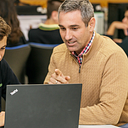How can kids learn to code?
With the introduction of programming subjects in the British curriculum, teachers and parents are asking how do we even start?
Around 2013, the British curriculum introduced Computer Science as a compulsory subject in KS1, KS2 and KS3, and as an elective in KS4. This means that pupils as young as 5 years old are required to learn what algorithms are, how to debug and execute a program, among other digital tasks. So, where do we start?
The British National Curriculum identifies the Computational Thinking objectives that need to be learnt, such as decomposition, pattern recognition, abstraction and algorithms. But what programming really does is teach pupils the “soft skills”, such as problem resolution, the management of frustration, team-work, communication and time management, to name a few. What we should realise is that programming languages such as Python are the tools used to implement these soft skills, then we are on our way to teaching Computer Science in its essence — the resolution of problems.
So how do we get a 5 year old pupil, who is just learning to write and read, to the end product of an efficient problem solver using technology as the tool?
By spending many of the younger years using visual programming applications such as Scratch, Blockly games or code.org, pupils play, have fun, are challenged, solve problems, and don’t even realise they are learning how to implement “sequence, selection, and repetition in programs”, in a practical manner, without even knowing how to read or write. The drag-and-drop interfaces offered by these online applications allow younger pupils to easily code print statements, loops and arrays, without the worry of syntax errors. After many, many sessions (or years) of this visual-based programming, the move to real-world programming languages like Python is seamless, and requires little or no explanations.
Other game-oriented visual interfaces include Microsoft’s https://arcade.makecode.com/ now with simple tutorials to get kids started off themselves.
Gamefroot also give kids a chance to make their own games. Using this tool, they learn about game product creation, such as having a goal, earning points, levels, enemies, etc. It’s much better for them to create their own game, rather than play others, don’t you think?
When to move to Python?
If this visual programming methodology is followed, pupils at the age of 8 or 10 can seamlessly move onto Python through online applications such as Trinket. Google Colaboratory nowadays also offers an excellent Python programming environment, where students can learn to write and execute Python code through the browser, giving them an easy option to move into Machine Learning and Data Analysis at an early age.
I have been using https://replit.com/ with my family, recently upgraded to offer an improved user interface.
As your child gets more mature and proficient with Python, you can start to instil programming by incorporating coding into their everyday school class activities. For example, with a little assistance, this 11 year old was able to check his maths homework using Python.
However, with all these online tools now available, don’t underestimate the influential role of a good programming coach, which can also include parents or siblings. He or she provides variety in the programming tasks, individual and personalised attention when needed, engaging introductions and summaries to the lesson, long-term planning and personalised projects to focus on soft skills mentioned previously.
